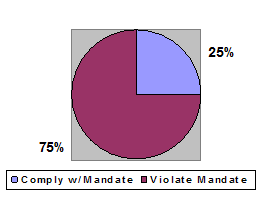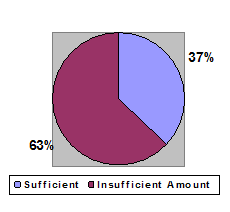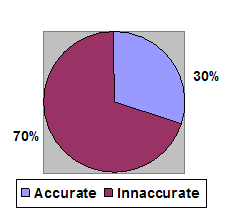|
Given the pressing need for health education among New York's children, we undertook
a groundbreaking investigation of the New York City education system. We focused on
health education for grades K-8 because of the tremendous promise in teaching younger
children about good health, as most health habits tend do develop at earlier ages.
To assess the status of health education in grades K-8 in New York City public schools, we
conducted interviews of health coordinators, or the most senior staff member responsible
for health education, at the district level.02
We posed a series of questions to health coordinators to determine the following:
-
Whether the districts could identify the State and City health education mandates;
-
Whether the districts actually follow such mandates; and
-
Which, if any, oversight procedures exist to track implementation and effectiveness at
the district level.
(Please see Appendix B for a summary of survey responses. In order
for the district health coordinators to cooperate with our survey, we promised to keep
specific names confidential.)
At the conclusion of our research, we were able to interview personnel responsible for
health education at 27 out of 32 districts throughout New York City, with 5 districts either
unwilling or unable to respond to our inquiries.37
Broken down by borough, we interviewed 5 out of 6 districts in the Bronx, 11 out of 12
districts in Brooklyn, 5 out of 6 districts in Manhattan, 5 out of 7 districts in Queens and
the 1 district in Staten Island.
Our Findings
Our investigation reveals that districts are overwhelmingly unaware of, and unable to comply
with, even the minimal New York State and City's current mandates on health education. This
distressing problem stems from enormous obstacles facing school districts, most notably a
severe lack of trained teachers, time, money and centralized direction from State and local
government. The findings below uncover for the first time the appalling state of health
education that is available to New York's children.03
FINDING #1 a-
-75% OF DISTRICTS VIOLATE AT LEAST ONE OF THE GOVERNMENT REQUIREMENTS FOR HEALTH
EDUCATION
FINDING #1 b-
-63% OF DISTRICTS SPECIFICALLY VIOLATE THE MANDATE TO HAVE A SUFFICIENT NUMBER OF PROPERLY
TRAINED TEACHERS FOR INSTRUCTION OF EITHER HIV/AIDS OR FL/SE CURRICULA
Upon analyzing the data captured from our interviews, we discovered that at least 75% of
districts in New York City are violating at least one of the State and City mandates for
health education. With such a large percentage of districts out of compliance with some
portion of curriculum and teacher training guidelines, one has to wonder what purpose the
health education mandates really serve. As the budget crisis continues to deplete available
funds for education, problems will inevitably worsen.
In many instances, districts are simply incapable of meeting these mandates because they
lack an adequate number of trained teachers. In fact, our survey finds that at least 63%
of districts admit to not having enough trained or certified teachers to fulfill the
requirements for health instruction. Several district administrators voice frustration
at the lack of support provided by the City in fulfilling teacher training mandates, as
exemplified by one official's concerns, "The Board of Ed used to pay for training,
but now it comes out of the district's budget . . . we have to pay for a substitute for
each day the teacher is away, which costs us like $150 to $200 per day."
Echoing the problems encountered decades ago, some districts cite teacher embarrassment
and discomfort as a major barrier in presenting health education material. As one district
coordinator explains, "teachers aren't trained well enough and are scared to [teach
sex education and] offend someone."
Schools also have difficulty complying with health education requirements because such
little time is available during the already overscheduled school day. After teaching core
subjects, such as math and reading, educators only have a small portion of each day to
devote to art, music, health and physical education. As one administrator reports,
"So much time [in the school day] is blocked out . . . there are only 20 minutes
before lunch and 40 minutes in the afternoon [for other areas, such as health] and there is
a lot of competition among different mandates." The administrator succinctly sums
up the main point: "Anyone saying that health ed. is fine in the districts
is telling you a story."
According to many district coordinators, health takes such a backseat to core subjects
because of pressures to increase math and reading scores. The lack of performance measures
on health education compel teachers to push aside health instruction in favor of other
lessons more directly linked to higher test scores. In light of these factors, the high
rate of non-compliance with State and City mandates is not surprising. One health
coordinator sums it up, by stating, "I guess the Board figures some things are
more expendable in terms of testing needs."
To counter these time constraints, the DOE encourages districts to incorporate their health
lessons into literacy blocks, such as bringing up health statistics in math class or
teaching children how to read from passages concerning health issues.
|
The State and City jointly gave mini-grants to low-performing schools in 1999 and
2000 to formulate a plan to integrate health skills with literacy skills. However,
this grant program has been discontinued since 2001.
|
As one DOE employee explains, "[H]ealth has always been second rate because the
pressure is on for improved reading scores. In fact, in some schools that is all they
prepare for." He continues, "The selling point for health programs is 'health
literacy' - it links health content to other academic skills." This approach
currently receives neither coordinated oversight by the districts nor any assessment by
the City.
FINDING #2 - 70% OF DISTRICTS INACCURATELY DESCRIBE ONE OR MORE OF THE HEALTH
EDUCATION MANDATES
Poor communication between the district health coordinators and DOE personnel about what
is actually mandated compounds this health education crisis in New York City schools. An
astonishing 70% of school districts cannot accurately describe all of the State and City
government mandates for health education, and strikingly some are unaware that such
mandates even exist.
A veteran district health coordinator expresses her concerns about this gap in information:
"This is not a unified discipline. We are all over the place and it is hard to
focus in any one area. When I first started, it was really hard to find someone at the top
to explain to me how things worked." Other administrators do not even seem to be
aware of their lack of knowledge. As one administrator states,
"[T]here
are no mandates. Health ed is based on budget constraints and up to each principal's
discretion."
A handful of districts do not have the required health coordinator position and charge
alternative administrators to oversee the instruction. However, most of the alternative or
temporary appointments are either severely under-qualified or under-trained for the position.
One such appointee states, "[T]here is no health education required on the
elementary level . . . but, I don't know for sure." This temporary health
administrator continues, "Schools may be [required] to have a certified health
teacher, but I am unsure of what the credentials are." Sadly, there is no one else
in this district to fill in the holes in the appointee's knowledge.
FINDING #3 - 70% OF DISTRICTS DO NOT ACTIVELY OVERSEE HEALTH INSTRUCTION IN INDIVIDUAL
SCHOOLS
We discovered a shocking 70% of districts do not actively monitor health instruction, but
instead merely rely upon principals to track compliance at their discretion. This deficiency
in district level oversight highlights the overwhelming lack of incentives in place to
motivate schools to comply with health requirements. Perhaps one coordinator states the
realities faced by districts best in observing, "Look, we have over 20 schools in
our district. It would be near impossible to know what is going on in each one."
Another district coordinator laughs while saying,
"I serve a total of five
positions on the district level. As an army of one, I am spread so thin that to monitor the
schools would be impossible."
Without adequate oversight, it is impossible
to guarantee that our students receive the health education to which they are entitled.
"Regardless of whether a state mandates sex education or AIDS education, there is no
guarantee that the subject will be taught in all school districts, because many states do
not have a mechanism for monitoring program implementation. In fact, there is often wide
variation in what is taught, both within school districts and even within the same
school."
-Alan Guttmacher Institute, 1998
|
These problems are hardly unique to New York City. Health program officials across the
country have difficulty verifying the instruction of required health classes, and many
administrators and educators are deprived of the support they need to make health a priority
for our nation's children. As noted in a recent article in the Journal of School Health,
"Except in response to specific crises, administrators and school health advocates
receive limited support for programs which, by their very existence, confirm that local
children and youth face risks for negative health
consequences."38
FINDING #4 - 63% OF DISTRICTS COMPENSATE FOR GAPS IN STATE & CITY MANDATES
Our most encouraging finding is that school districts want to provide effective health
education. In fact, 63% of districts report launching their own initiatives to fill the
substantial gaps in the State and the City mandates. For instance, some districts and many
individual schools adopt health topics and curricula that go well beyond the State and
City's requirements. One district health coordinator elects to supplement the HIV/AIDS
curriculum by teaching about other commonly-contracted STDs.
Despite the promise of such programs, this discretionary instruction raises several
concerns, such as how to confirm that qualified educators are performing this instruction,
as well as how to ensure the material is accurate and appropriate for the students. Without
a system of oversight and assessment over the instruction afforded to our students, we
cannot provide the appropriate assurances for parents and the community at large regarding
these issues.
The DOE does provide some extra support for districts in delivering health education to New
York City schoolchildren through its collaboration with the New York Academy of Medicine
(NYAM). Contingent upon a contract with the City, the NYAM provides comprehensive curricula
and teacher training for schools on a voluntary
basis.39
Districts also have access to other community resources to assist them in developing more
comprehensive health education, such as those provided by Planned Parenthood and other
non-profits and community organizations. The CDC and the State Department of Health also
provide grants for specialized instruction, a resource that a few New York City school
districts have utilized over the years. Districts have also made laudable attempts to
increase knowledge of health in their schools by organizing health fairs for students and
parents, as well as coordinating workshops presented by outside providers on topics such
as violence and drug abuse.
While most of these ad hoc programs are short-lived due to budgetary constraints and
personnel turnover, they demonstrate the desperate need of New York City's districts and
schools to have more and better health information for their students. In fact, when
asked to comment on the sufficiency of the State and City curricula mandates, one
district health coordinator states,
"I just hope teachers are putting
forth the effort to do more than just the mandated curriculum. This is my
hope."
Our empirical and anecdotal findings illustrate the utter disarray of health education in
New York City public schools. There is no accountability among any person or entity at
the State, City or district level regarding the status of health instruction in schools.
While the reasons for this neglect vary, ranging from the interference of political and
cultural agendas to poor communication between the DOE and the individual districts to
insufficient funding for teacher training and health programs in schools, the need for a
more comprehensive and accountable health education program is abundantly clear.
|




